Life in a Medieval Village
Read Life in a Medieval Village Online
Authors: Frances Gies


Frances and Joseph Gies

To Dorothy, Nathan, and Rosie
4 THE VILLAGERS: WHO THEY WERE
5 THE VILLAGERS: HOW THEY LIVED
I
N THE DISTRICT OF HUNTINGDON THERE IS A CER
tain village to which far-distant antiquity gave the name of Aethelintone,” wrote the twelfth-century monk who chronicled the history of Ramsey Abbey, “on a most beautiful site, provided with a course of waters, in a pleasant plain of meadows with abundant grazing for cattle, and rich in fertile fields.”
1
The village that the Anglo-Saxons called Aethelintone (or Aethelington, or Adelintune), known in the thirteenth century, with further spelling variations, as Aylington, and today as Elton, was one of the thousands of peasant communities scattered over the face of Europe and the British Isles in the high Middle Ages, sheltering more than 90 percent of the total population, the ancestors of most Europeans and North Americans alive today.
Many of these peasant settlements were mere hamlets or scattered homesteads, but in certain large areas of England and Continental Europe people lived in true villages, where they practiced a distinctive system of agriculture. Because England has preserved the earliest and most complete documentation of the medieval village, in the form of surveys, accounts, and the
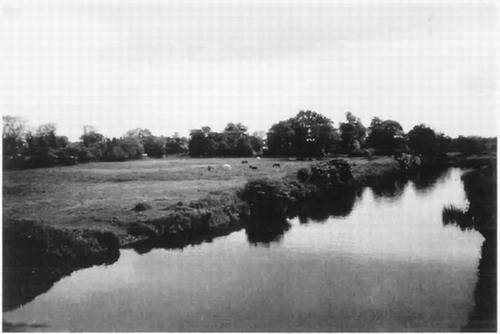
The River Nene at Elton.
*
rolls of manorial courts, this book will focus on an English village.
Medieval villages varied in population, area, configuration, and social and economic details. But Elton, a dependency of wealthy Ramsey Abbey, located in the East Midlands, in the region of England where villages abounded and the “open field” agriculture associated with them flourished, illustrates many of the characteristics common to villages at the high point of their development.
Elton stands today, a village of about six hundred people, in northwest Cambridgeshire.
†
seventy miles north of London, where it has stood for more than a thousand years. Its presentday gray stone houses cluster along two axes: one the main road from Peterborough to the old market town of Oundle; the other, at right angles to it, a street that ends in a triangular village green, beyond which stands an eighteenth-century mill
on the banks of the River Nene. Smaller streets and lanes intersect these two thoroughfares. The two sections have long been known as Overend and Nether End. Nether End contains the green, with a Methodist chapel adjoining. Near the river here the construction of a floodbank in 1977 uncovered the foundations of the medieval manor house. Overend centers around the church, with its school and rectory nearby. At the southern limit of Overend stands the village’s tourist attraction, Elton Hall, a stately home whose gatehouse and chapel alone date as far back as the fifteenth century, the rest from much later.
Two pubs, a post office/general store, and a garage comprise Elton’s business center. Buses and cars speed along the Peterborough-Oundle road. Some of the cottages, nestling in their neat gardens, are picturesquely thatched. Off beyond the streets, sheep graze in the meadows. Yet Elton, like many other English villages, is no longer a farming community. Most of its inhabitants work in nearby Peterborough, or commute to London. The family that owns Elton Hall operates an agricultural enterprise, and one independent farmer lives in the village; two have farms outside, in the parish. A few descendants of farm laborers live in subsidized housing on a Council estate.
Except perhaps for the sheep, almost nothing medieval survives in twentieth-century Elton. In the northwest corner of the churchyard, inconspicuous in the shadow of the great square tower, stand the oldest identifiable objects in Elton, a pair of Anglo-Saxon crosses found during a nineteenth-century restoration of the church.
*
The present building is mainly the product of the fourteenth and fifteenth centuries; only the stones of the chancel arch date from the thirteenth.
The oldest house surviving in Elton today was built in 1690. Medieval Elton, its houses, yards, sheds, and gardens, the smithy, the community ovens, the cultivated fields, even the meadows, marsh, and woods have vanished. Not only were medieval villages constantly rebuilt, but as forms of agriculture changed and new kinds of landholding were adopted, the very
fields and meadows were transformed. We know how villages like Elton looked in the Middle Ages not so much from modern survivals as from the recent investigation of England’s extraordinary archeological trove of deserted villages, victims of dwindling population, agricultural depression, and the historic enclosure movement that turned them from busy crop-raising communities to nearly empty sheep pastures. More than two thousand such sites have been identified. Their investigation, based on a technique introduced into England during World War II by German refugee Gerhard Bersu, was pioneered in the 1950s by archeologist John Hurst and historian Maurice Beresford in the now famous Yorkshire deserted village of Wharram Percy. Excavation and aerial photography have since recovered
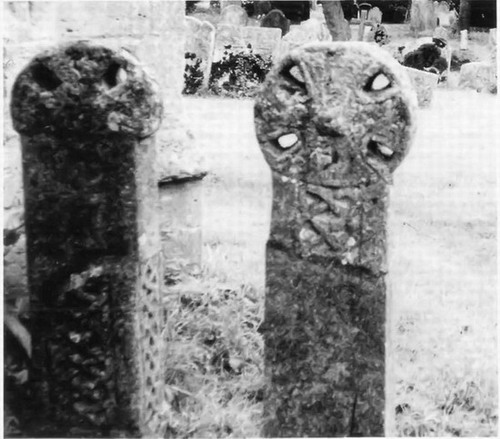
Two crosses in the churchyard, dating from the eleventh century or the beginning of the twelfth, are the oldest monuments in Elton.

The deserted village of Wharram Percy. Only the ruins of St. Martin’s church still rise above ground, but street plan and layout of houses have been recovered.
the medieval shape of many villages, the sites of their houses and enclosures, and the disposition of fields, streets, paths, and embankments.
2
The deserted villages, however, left few written records. These are rich, on the other hand, for many of the surviving villages. They document not merely details of the houses and holdings, but the names of the villagers themselves, their work arrangements, and their diet, recreation, quarrels, and transgressions. Much can be learned from the records of the Ramsey Abbey villages, of which Elton was one, and those of contemporary estates, lay as well as ecclesiastical. The documents are often tantalizing, sometimes frustrating, but supplemented by the archeological record, they afford an illuminating picture of the open field village, a community that originated in the central Middle Ages, achieved its highest stage in the late thirteenth century, and left its mark on the European landscape and on Western and world civilization.
THE VILLAGE
EMERGES
I
N THE MODERN WORLD THE VILLAGE IS MERELY A
very small town, often a metropolitan suburb, always very much a part of the world outside. The “old-fashioned village” of the American nineteenth century was more distinctive in function, supplying services of merchants and craftsmen to a circle of farm homesteads surrounding it.
The medieval village was something different from either. Only incidentally was it the dwelling place of merchants or craftsmen. Rather, its population consisted of the farmers themselves, the people who tilled the soil and herded the animals. Their houses, barns, and sheds clustered at its center, while their plowed fields and grazing pastures and meadows surrounded it. Socially, economically, and politically, it was a community.
In modern Europe and America the village is home to only a fraction of the population. In medieval Europe, as in most Third World countries today, the village sheltered the over-whelming majority of people. The modern village is a place where its inhabitants live, but not necessarily or even probably
where they work. The medieval village, in contrast, was the primary community to which its people belonged for all life’s purposes. There they lived, there they labored, there they socialized, loved, married, brewed and drank ale, sinned, went to church, paid fines, had children in and out of wedlock, borrowed and lent money, tools, and grain, quarreled and fought, and got sick and died. Together they formed an integrated whole, a permanent community organized for agricultural production. Their sense of common enterprise was expressed in their records by special terms:
communitas villae,
the community of the vill or village, or
tota villata,
the body of all the villagers. The terminology was new. The English words “vill” and “village” derive from the Roman
villa,
the estate that was often the center of settlement in early medieval Europe. The closest Latin equivalent to “village” is
vicus,
used to designate a rural district or area.
A distinctive and in its time an advanced form of community, the medieval village represented a new stage of the world’s oldest civilized society, the peasant economy. The first Neolithic agriculturists formed a peasant economy, as did their successors of the Bronze and Iron Ages and of the classical civilizations, but none of their societies was based so uniquely on the village. Individual homesteads, temporary camps, slave-manned plantations, hamlets of a few (probably related) families, fortresses, walled cities—people lived in all of these, but rarely in what might be defined as a village.
True, the village has not proved easy to define. Historians, archeologists, and sociologists have had trouble separating it satisfactorily from hamlet or settlement. Edward Miller and John Hatcher
(Medieval England: Rural Society and Economic Change, 1086-1343)
acknowledge that “as soon as we ask what a village is we run into difficulties.” They conclude by asserting that the village differs from the mere hamlet in that “hamlets were often simply pioneering settlements established in the course of agricultural expansion,” their organization “simpler and more embryonic” than that of the true village.
1
Trevor Rowley and John Wood
(Deserted Villages)
offer a “broad definition” of the village
as “a group of families living in a collection of houses and having a sense of community.”
2
Jean Chapelot and Robert Fossier
(The Village and House in the Middle Ages)
identify the “characteristics that define village settlement” as “concentration of population, organization of land settlement within a confined area, communal buildings such as the church and the castle, permanent settlement based on buildings that continue in use, and…the presence of craftsmen.”
3
Permanence, diversification, organization, and community—these are key words and ideas that distinguish the village from more fleeting and less purposeful agricultural settlements.
Archeology has uncovered the sites of many prehistoric settlements in Northern Europe and the British Isles. Relics of the Bronze Age (roughly 3000 B.C. to 600 B.C.) include the remains of stone-walled enclosures surrounding clusters of huts. From the Iron Age (600 B.C. to the first century A.D.), circles of postholes mark the places where stood houses and sheds. Stones and

Circle of megaliths at Avebury (Wiltshire), relic of Neolithic Britain.
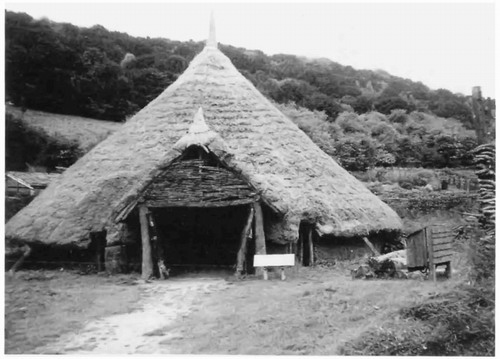
Reconstruction of Iron Age house on site of settlement of c. 300
B.C.
, Butser Ancient Farm Project, Petersfield (Hampshire).
ditches define the fields. Here we can first detect the presence of a “field system,” a historic advance over the old “slash and burn” agriculture that cleared, cultivated, then abandoned and moved on. The fields, delineated by their borders or barriers, were cultivated in a recognized pattern of crops and possibly fallow.
4
The so-called Celtic fields, irregular squares of often less than an acre, were cultivated with the ard, a sharpened bough of wood with an iron tip, drawn by one or two oxen, which scratched the surface of light soil enough to allow sowing. Other Iron Age tools included hoes, small sickles, and spades. The rotary quern or hand mill (a disklike upper stone turning around a central spindle over a stationary lower stone) was used to grind grain. Crops included different kinds of wheat (spelt, emmer), barley, rye, oats, vetch, hay, flax, and dye-stuffs. Livestock were cattle, pigs, sheep, horses, domestic fowl, and honeybees.
5
A rare glimpse of Iron Age agriculture comes from the Roman
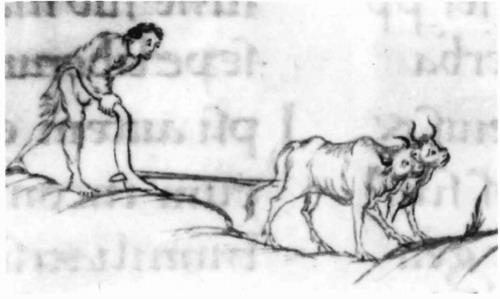
Scratch plow, without coulter or mouldboard, from the Utrecht Psalter (c.
A.D.
830). British Library, Harley Ms. 603, f. 54v.
historian Tacitus, who in his
Germania
(
A.D.
98) describes a farming society primitive by Roman standards:
Land [is divided] among them according to rank; the division is facilitated by the wide tracts of fields available. These plowlands are changed yearly and still there is more than enough…Although their land is fertile and extensive, they fail to take full advantage of it by planting orchards, fencing off meadows, or irrigating gardens; the only demand they make upon the soil is to produce a grain crop. Hence even the year itself is not divided by them into as many seasons as with us: winter, spring, and summer they understand and have names for; the name of autumn is as completely unknown to them as are the good things that it can bring.
Tacitus seems to be describing a kind of field system with communal control by a tribe or clan. The context, however, makes it clear that he is not talking about a system centered on a permanent village:
The peoples of Germany never live in cities and will not even have their houses adjoining. They dwell apart, scattered here and there, wherever a spring, field, or grove takes their fancy. Their settlements
(vici)
are not laid out in our style, with buildings adjacent and connected…They do not…make use of masonry or tiles; for all purposes they employ rough-hewn timber…Some parts, however, they carefully smear over with clay…They also dig underground caves, which they cover with piles of manure and use both as refuges from the winter and as storehouses for produce.
6
Tacitus here is referring to the two main house types that dominated the landscape into the early Middle Ages. The first was the timber-framed building, which might, as in his account, be covered with clay, usually smeared over a framework of branches (wattle and daub), its most frequent design type the longhouse or byre-house, with animals at one end and people at the other, often with no separation but a manure trench. The second was the sunken hut or
grubenhaus,
dug into the soil to the depth of half a yard to a yard, with an area of five to ten square yards, and used alternatively for people, animals, storage, or workshop.
The Roman occupation of Gaul, beginning in the first century B.C., and of Britain, starting a century later, introduced two types of rural community to northwest Europe. The first was the slave-manned villa, a plantation of 450 to 600 acres centered on a lord’s residence built in stone. The second was similar, but worked by peasants, or serfs, who cultivated their own plots of land and also that of their lord.
7
To the native Iron Age crops of wheat, barley, flax, and vetch, the Romans added peas, turnips, parsnips, cabbages, and other vegetables, along with fruits and the grape.
8
Plows were improved by the addition of iron coulters (vertical knife-blades in front of the plowshare), and wooden mouldboards, which turned the soil and made superfluous the cross-plowing (crisscrossing at right angles) formerly
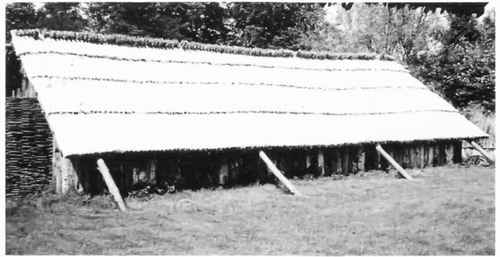
Reconstruction of Iron Age longhouse (c.
A.D.
60) at Iceni Village, Cockley Cley (Norfolk).
practiced. Large sickles and scythes were added to the Iron Age stock of tools.
9
The Romans introduced not only a craftsman’s but an engineer’s approach to farming: wells, irrigation systems, the scientific application of fertilizer, even consideration of the effect of prevailing winds on structures. The number of sheep and horses increased significantly.
10
The Romans did not, however, work any revolution in basic agricultural methods, and the true village remained conspicuous by its absence. In Britain, in Gaul, and indeed throughout the Empire, the population dwelt in cities, on plantations, or dispersed in tiny hamlets and isolated homesteads.
Sometimes small pioneering groups of settlers entered an area, exploited it for a time, then moved on, whether because of deficient farming techniques, a fall in population, military insecurity, or a combination of the three. Archeology has explored a settlement at Wijster, in the Netherlands, dating from about
A.D.
150, the site of four isolated farmsteads, with seven buildings, four large houses and three smaller ones. In another century, it grew to nineteen large and seven small buildings; by the middle of the fifth century, to thirty-five large and fourteen
small buildings in an organized plan defined by a network of roads. Wijster had, in fact, many of the qualifications of a true village, but not permanence. At the end of the fifth century, it was abandoned. Another site was Feddersen Wierde, on the North Sea, in the first century B.C., the setting of a small group of farms. In the first century
A.D.
the inhabitants built an artificial mound to protect themselves against a rise in water; by the third century there were thirty-nine houses, one of them possibly that of a lord. In the fifth century it was abandoned. Similar proto-villages have been unearthed in England and on the Continent dating on into the ninth century.
11
